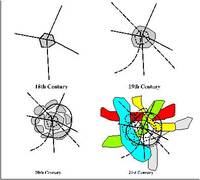- England
- Scotland
- France
- Holland
- Germany
- Italy
- Spain
- Portugal
- USA
- China
- Japan
- India
- Iran
- Advice
- Gardens
- England
- Scotland
- France
- Holland
- Germany
- Italy
- Spain
- Portugal
- USA
- China
- Japan
- India
- Iran
- Advice
- Garden Tours
Book: Landscape Planning and Environmental Impact Design: from EIA to EID
Chapter: Chapter 11 Urbanisation and growth management
Planning commercial projects like fried eggs disregards the public good. Modern commercial projects are planned by property specialists for the near-exclusive benefit of their land owners. Too often, developments in what Joel Garreau has dubbed Edge City tend to be on the fried egg pattern: each gleaming structure rises from a flabby skin of car rooftops [Fig 11.26]. At the start, each egg appears as an isolated phenomenon, set in a wooded or agricultural landscape. Later on, more eggs are laid and the car parks coalesce. The aesthetic and ecological disadvantages to the firstcomer, may well be offset by the advantages of better local services and an increased pool of skilled labour. 11.26 Edge cities are characterised by 'fried egg' site planning. Planners see edge cities as chaotic places. They are in fact the consequence of powerful economic and social factors: the location of executive housing, schools, educational institutions, power lines, airports, railway stations and, above all, roads. You cannot have an Edge City without a good infrastructure and the way to make Edge Cities even better is to improve the infrastructure. This requires planning. When a major new highway is built through undeveloped land, we must expect Edge Cities to mushroom near road junctions. The land has to be planned and the best way is to draw up proposals for a variety of greenways. In the short term, they may not be as important as roads. In the long term, they are more important, because they provide for the evolution of the area into a higher density town. Greenways should be planned for all the separate reasons which were discussed in Chapter 4: pedestrian and cycle circulation, surface water drainage, wildlife corridors, recreation, visual amenity. ities developed around roads. Future cities should develop around greenways [Fig 11.27]. 11.27 In the twenty-first century, city development should be preceded by the designation of various types of greenway, as shown in the lower left diagram. Garreau believes that the developers of Edge Cities are opposed to public open space for security reasons. If this is really the case, it may not be possible to have greenways which are open to the public, but they should still be planned at the start of the urbanisation process. Some can have restricted access. Some can provide benefits other than recreation. Some can opened to the public when there is sufficient visual policing to make the space safe. The principle is clear: 'greenways first in urban development'.


